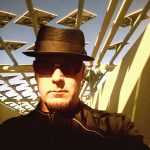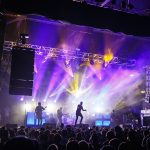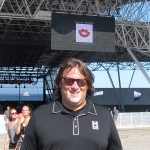PLSN Talks with Several Designers About illuminating Prince
It was a sad day in the city of Minneapolis last month. The musical icon who put the First Avenue performance venue and this city on the musical map had passed on. The streets outside the club where Prince Rogers Nelson had filmed Purple Rain some 30 years ago closed down as the masses gathered to “get through this little thing we call life.”

Sure, some tears were shed. But they quickly turned to joy as more than 20,000 people turned the scene into one gigantic dance party, one suitable for their Prince. In retrospect we talked to several lighting designers who have spent part of their career working with Prince, The Artist formerly Known as Prince, The symbol, The Dude, then Prince again. After lighting Prince for 14 years, Roy Bennett (see Designer Profile) stepped aside, and some other great people stepped up to take a turn. Here are their words.
Peter Morse
One day in 1994, I received a cold call from Prince. Apparently he was a big fan of Bette Midler’s, and he had just seen several of her shows during her month-long run at Radio City. He was calling to ask if I would like to design his lighting for a new tour. Once I pulled myself together, I responded that — as much as I wanted to be involved, I would first need to make a call. He agreed. I immediately phoned Roy Bennett, who had been Prince’s designer for many years. Roy gave me his blessing. So I confirmed with Prince. He flew me to Minnesota, where I spent several days at Paisley Park, watching band rehearsals and discussing Prince’s theory on improvement of lighting direction and timing. He explained that he wanted to control all the lighting via MIDI from his guitar(s) —- whether via pedals or other means… I told him that anything is possible. However, timing would certainly suffer, as would other elements (i.e., focus, color, presets, etc.). This particular tour never materialized.
However, ten years later, in 2004, I was contacted again to come design his Musicology tour. I flew down to his rehearsals in L.A. Within 10 minutes of my arrival, he took me aside and once again inquired into the concept of his controlling all the stage lighting via his guitar. I had to remind him of our previous conversation. Then he winked and smiled. Once we got beyond that discussion, rehearsals proceeded.
Prince had very specific ideas for lighting looks and cues for practically every moment of his show. He was a great visualizer, who truly had a wonderfully artistic grasp on what his music should look like—-as well, of course, sound like! He would call for total blackouts at times that made little sense visually. However, when executed, the musical/theatrical impact was intense.
The one comment he made to me that fairly well says it all: “My show must be like a beautiful quilt that flows, but has sharp edges. And I want to have control of every single thread — its color, its thickness, its brightness — from one edge to the other.”
James Poepping
When I worked with Prince, it was at a time when he had just changed his name to a symbol. So what do you call someone with a symbol for a name? One day I got called out to his bus. When I got there he was in his chair watching TV. He started some small talk. Then the real reason I was called out came about. “Do you know how to record a show on the VCR?” I said yes. Then he asked me to make sure that I set the VCR to record a Chicago Bulls game, so he could watch after the show. When I got done he asked me, “So it’s going to record right?” I said yes. Then he said, “Well, if it doesn’t you’re fired.” I couldn’t tell if he was joking or serious. Still can’t.
He was a very thorough person about everything. He would come out to FOH in a road case. Security would put him in a case and roll him out there as if no one would see this going on. He would then get out of the case in a costume of sorts and proceed to the FOH to mix the audio. He always played his ass off — usually past all the curfews, which he paid for in advance. Then play for a few more after the show at a club somewhere. He was non-stop, and it was an honor to work with him. R.I.P.
Mark “Fifi” Miller
Prince, or as I knew him, as “The Artist, TAFKAP, or Sir” — there were others, but we will stick with those. Time with Prince was a learning curve like nothing I had ever experienced before or after in my career. For something that was supposed to last a few weeks turned out to be the e-ticket of a lifetime. Interacting with Prince was interesting and sometimes down right painful. Life with him was a challenge, to say the least, but for all of the crazy that I went through, and believe me I have some stories, I would do it all again!
They say that there is a fine line between genius and madman, and I truly believe the he walked that tightrope every day. R.I.P., Prince, and thanks for all of the memories.
Jon Pollak
Lenny Kravitz decided to take a year off and farmed me out to the Paisley camp after Prince performed with Lenny on a few shows. Prince demanded perfection from everyone involved. We had countless full band and crew post show debriefs on mistakes and miscues, and he charted the meetings with a checklist. He was the one artist that reminded me of a top line F1 driver.
One who accepted no excuses in regards to his product and performance.
He taught me so much about musical timing and how to influence an audience that it formed a huge cornerstone in the execution of my work and remains to this day.
Toward the end of my tenure, he and I would have long theological conversations with Larry Graham about Seventh Day Adventism and the Millerite movement. About three weeks after the tour was over, I began to receive Saturday afternoon doorstep visits from various members of Jehovah’s Witness. It took a few weeks until it clicked that the Purple One had shopped my address to the local Kingdom Hall, just to keep me on my toes. His dedication to perfection fortified the focus on my craft and I owe him a great deal for making me a better artist. God will serve you now, Sir.
Demfis Fyssicopulos
(This is an excerpt from an email to PLSN editor Nook Schoenfeld, then a full-time LD, before Fyssicopulos’ death in 2014 —ed.) Nothing in the world could have prepared me for what Prince puts me through artistically. He reaches in and pulls out the best in me. It’s almost punishing, but very satisfying when I finally get where we need to be on some moment in a song. He pushed me past limits I didn’t know I had, and the end result is a pretty tight show. My only wish is we had someone in charge out here other than me so I could just do lights.
Craig Caserta
I have so many stories to share about Prince. He was an extremely funny, charismatic man who loved pranks, but one story that sticks out is this. While in rehearsals at Paisley Park, he just appeared at FOH not out of thin air, but he would often just appear in the room. While Prince, myself and one other person were having a conversation, he asked the third person if he had any mints. The guy reached into his pocket and took out a tin of Altoids and presented them to Prince. Prince had a sly grin on his face and responded, “They’re not for me.”
Other times he was funny while being dead serious. While at the Ogden Theater in Denver, Colorado, we had to move some vertical truss towers downstage due to some ramps that led to doorways off stage. When Prince got there for sound check, he noticed and asked me about it. I explained to him why, and he responded, ‘Well they need to move further downstage.’ This confused me, since they were already about five feet further down then they should be. I explained this to him, and he asked me if I noticed the doors that the towers were now blocking. Again explaining to him that the doorways were not physically blocked, he agreed, but also told me, from the audience view, the towers are in the middle of the doorway, thus blocking the flow and energy of the room. I thought he must be messing with me, but he was serious. The feng shui was more important than the proper lighting angle. The towers got moved another five feet downstage and were mid-stage towers for those two nights.
Working for him was a highlight of my career, and he pushed me every day to be better and would keep me on my toes by jumping out of the set list to do some random cover song I never heard the band play before.


